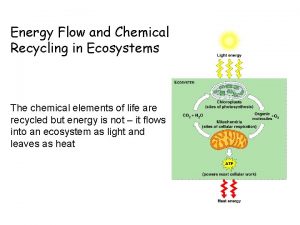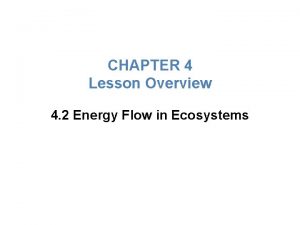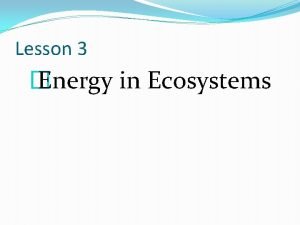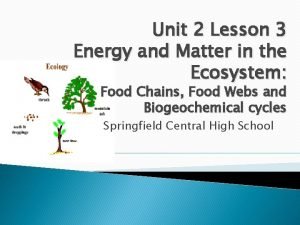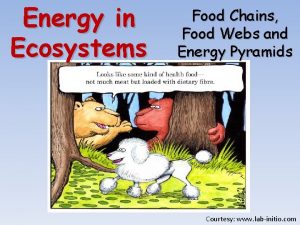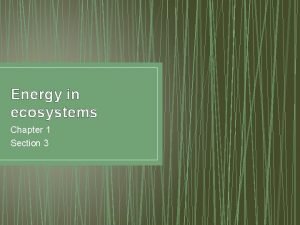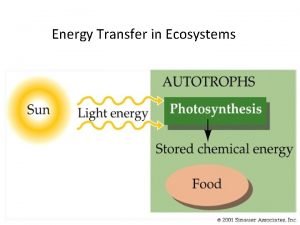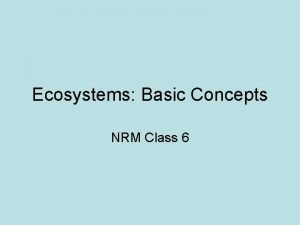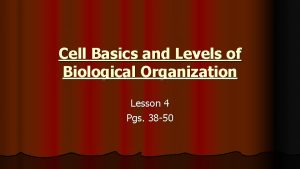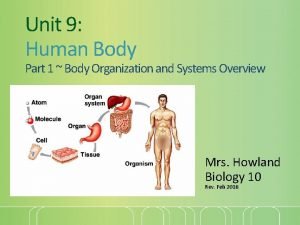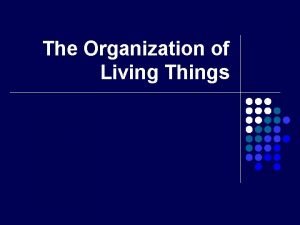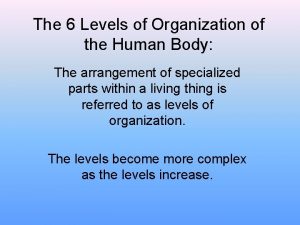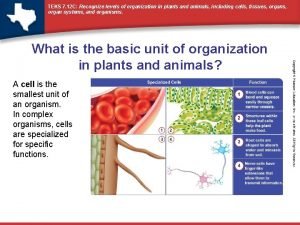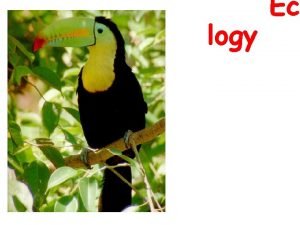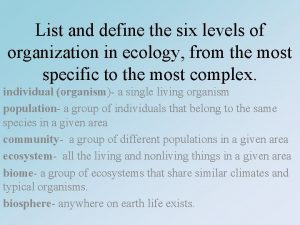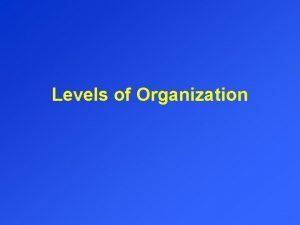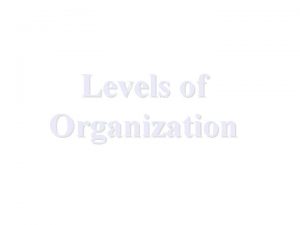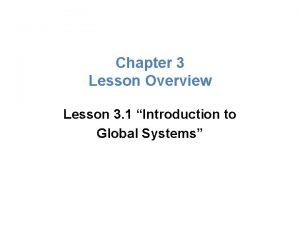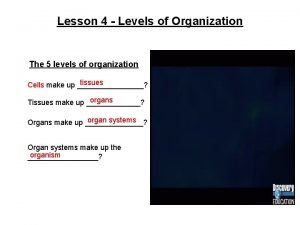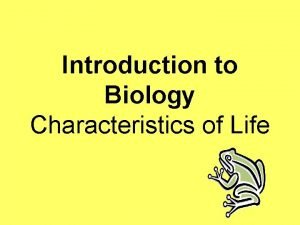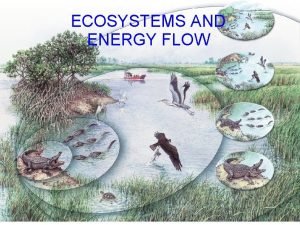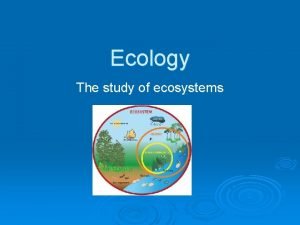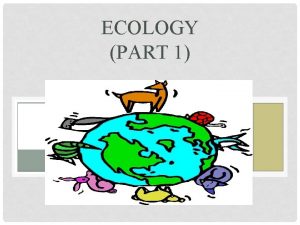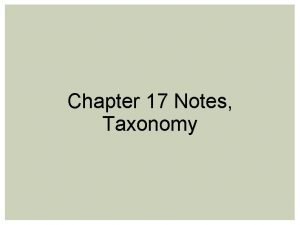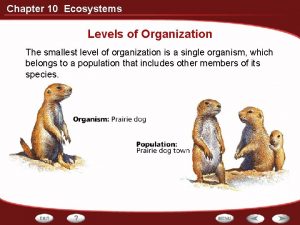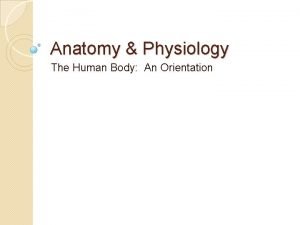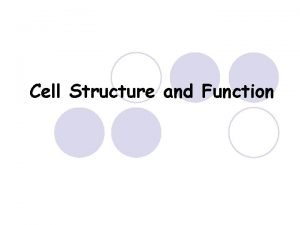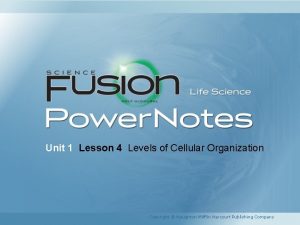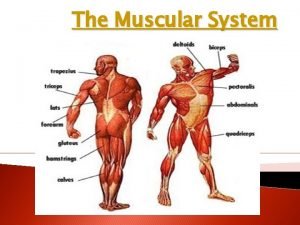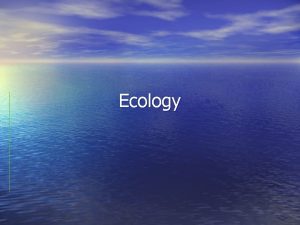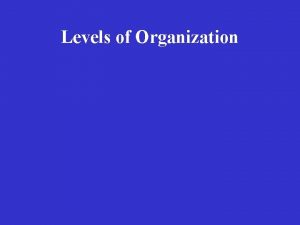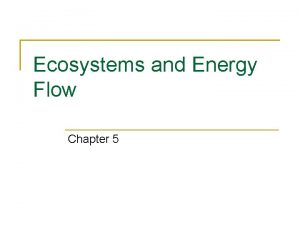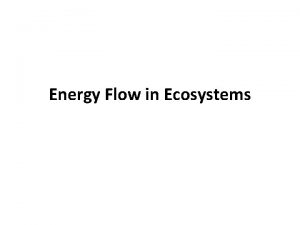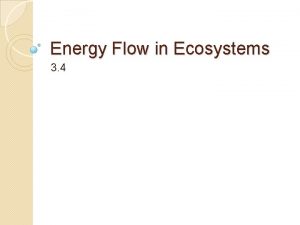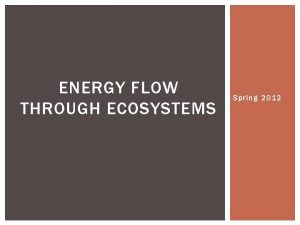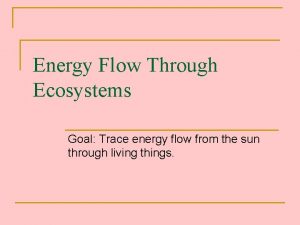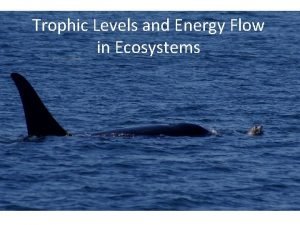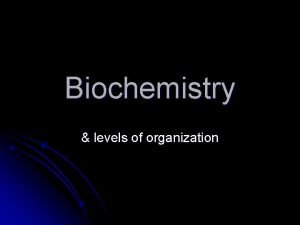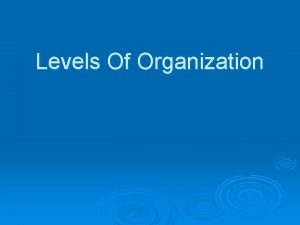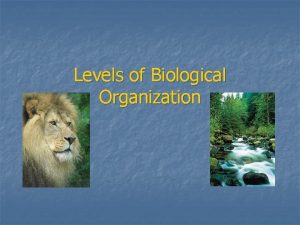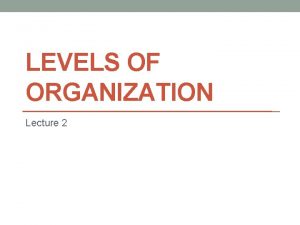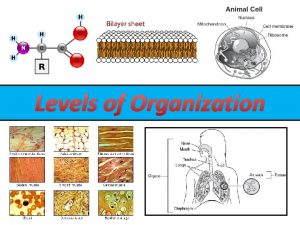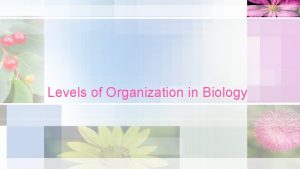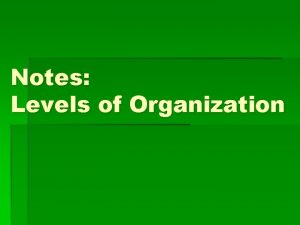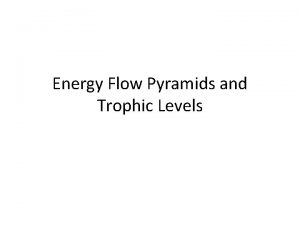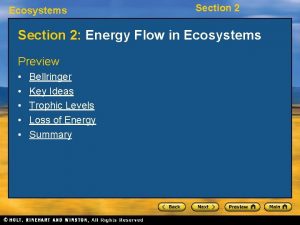ECOSYSTEMS AND ENERGY FLOW LEVELS OF ORGANIZATION What














































- Slides: 46

ECOSYSTEMS AND ENERGY FLOW

LEVELS OF ORGANIZATION


What Makes Up An Ecosystem?

Can you spot some abiotic/biotic factors?

Population density is affected by biotic/abiotic limiting factors Physical environments effect organisms. Limiting factor: any factor or condition that limits the growth of a population in an ecosystem Example: Oak trees cannot grow in the desert because there is not enough water there for oaks (and the ground cannot support its root system and the temperatures are too hot for the oak leaves); water is a limiting factor for oak trees Too little of something or too much of something is bad, but the right amount of it is essential.

limiting Factors No population can grow indefinitely due to limited resources such as light, water, and nutrients and also due to competitors and/or predators.

Types of Limiting Factors Density-Independent factors: A limiting factor that occurs regardless of how large the population is and reduces the size of ALL populations in the area in which they occur Density-dependent factors: A limiting factor of a population wherein large, dense populations are more strongly affected than less, crowded ones. (Dependent on the density of the population)

Habitat vs. Niche IN AN ECOSYSTEM: Organisms live in a Habitat Organisms fit into a Niche of the environment The wolf's habitat is the woods. His niche is a predator. Habitat- an area where an organism lives Niche- an organisms role in its environment The Long Version full range of physical and biological conditions in which an organism lives and the way in which the organism uses those conditions. Includes where in the food chain it is, where an organism feeds Habitat is like an address in an ecosystem and a niche is like an occupation in an ecosystem. Examples of a niche: Plants provide nesting sites as well as food. The droppings lefts behind by animals fertilize soil and often spread seed.

Community Interactions when organisms live together in an ecological community they interact constantly. Three types of interactions Competition Predation Symbiosis

Competition- competing for resources occurs due to a limited number of resources. When 2 or more organisms need the same resource at the same time. Resource- any necessity of life. water, nutrients, light, food. Competitive exclusion principle- no two species can occupy the same niche in the same habitat at the same time

Predation- when an organism captures and feeds on another organism. Predator- hunter Prey- hunted Fluctuations in predatorprey relationships are predictable. In this graph, you see: As the hare population increases, the lynx population also increases More prey = more food

Symbiosis: a definition Sym: From the greek/latin meaning “with” Bio: from the greek/latin meaning “to live” or “living” Symbiosis: A relationship where two organisms live together where at least one of the organisms benefits from the relationship. There are 3 major types: mutualism, commensalism, and parasitism

Mutualism Both organisms benefit from the relationship. Win-Win Racoon and Poison Ivy The raccoon eats the berries of the poison ivy and disperses the seeds as it poops. Both benefit.

Mutualism Black-eyed Susan gets pollinated by Green lacewing. Both benefit…lacewing gets food (nectar) and Black-eyed Susan gets pollinated. James L. Reveal, Norton-Brown Herbarium, University of Maryland Copyright, Edward S. Ross

Commensalism One organism benefits, the other one is unaffected. Win-Neutral relationship Red Maple and Eastern Bluebird nests in the maple. Maple is unaffected, bluebird benefits Copyright, Mark Brand, UConn Plant Database

Commensalism Eastern Chipmunk and Soil mite The chipmunk is a mammal that burrows. The soil mite feeds off of leaf litter but cannot burrow itself. The mite uses the chipmunk’s tunnels to travel from place to place. Copyright, Ray Norton

Parasitism One organism benefits, the other one is negatively affected Win-Lose relationship Parasites rarely kill their hosts…it would require them to get another one!

Parasitism Chigger lives and eats away at hognose snake. ATW from Kountry Life

ENERGY FLOWS IN AN ECOSYSTEM ENERGY ENTERS ECOSYTEM All energy in ecosystem comes from the sun First law of Thermodynamics: Energy cannot be created or destroyed (but it can be transformed into stored energy & heat)

ENERGY LEAVES ECOSYSTEM Second law of thermodynamics: Energy is lost as energy is transformed In ecosystem, when energy is transformed, some energy is lost as HEAT

ENERGY PATHS 3 ways to illustrate energy flow 2. Food Web: many paths 1. Food Chain: Single path 3. Food Pyramid

FOOD CHAINS A food chain shows the path of energy from one organism to the next energy flows from producers to consumers arrows point to who is eating (plant is eaten by herbivore) Usually decomposers are left out

Food Chains The energy flow from one trophic level to the other is know as a food chain Producers are at the first TROPHIC LEVEL Primary Consumers are the SECOND TROPHIC LEVEL Secondary consumers are at the THIRD TROPHIC LEVEL

FOOD WEBS A food web shows all feeding relationships in an ecosystem (made of many food chains)

FOOD WEBS Typically, food webs go like this: CONSUMER (CARNIVORE) CONSUMER (OMNIVORE) CONSUMER (HERBIVORE) PRODUCER remember: decomposers receive energy from all other organisms in an ecosystem DECOMPOSER

Food webs

Trophic Level Grass Mouse Grasshopper Frog Owl Hawk Producer, primary consumer, secondary consumer, tertiary consumer?

Trophic Level Producer, primary consumer, secondary consumer, tertiary consumer Producer Grass 1 st Mouse 2 nd Primary consumer Grasshopper 2 nd Primary consumer Frog 3 rd Secondary consumer Owl 3 rd and 4 th Hawk 3 rd Secondary and tertiary consumer Secondary consumer

FOOD CHAINS/WEBS & ENERGY PYRAMIDS Food chains/webs can be written as a pyramid: Producers form the base of the pyramid Consumers form the upper layers

ENERGY PYRAMIDS The energy pyramid shows energy flow in an ecosystem: A level of the energy pyramid is called a TROPHIC LEVEL Each trophic level represents the energy for those organisms Top Consumer Energy stored by Secondary Consumers Energy stored by Primary Consumers ENERGY STORED BY PRODUCERS

TROPHIC LEVELS Energy is lost with each trophic ~90% is released to the environment as heat ~10% of the energy is used Only about 10% of the energy from one level is passed on to the next level

Number Pyramid • Shows the numbers of individual organisms at each trophic level in an ecosystem. tertiary consumers 5 secondary consumers 5000 primary consumers 500, 000 producers 5, 000 • A vast number of producers are required to support even a few top level consumers.

Biomass pyramid • Biomass is a measure of the total mass of organisms at each trophic level in an ecosystem. tertiary consumers 75 g/m 2 150 g/m 2 secondary consumers primary consumers producers 675 g/m 2 2000 g/m 2

KEY CONCEPT: Matter cycles in and out of an ecosystem.

I. The Water Cycle 1. The hydrologic, or water cycle is the circular pathway of water on Earth. precipitation condensation transpiration evaporation surface runoff lake water storage in ocean groundwater see pag e

2. Key terms for the water cycle: a. Precipitation: moisture that falls to the ground (rain, snow, sleet, hail) b. Evaporation: changing from liquid to gas (water to water vapor) c. Transpiration: plants give off water vapor from their leaves to the air d. Condensation: changing from gas to a liquid (little water droplets form on the outside of a cold glass of lemonade - that’s condensation)

II. Oxygen Cycle: 1. Plants make food by photosynthesis They use carbon dioxide (CO 2) to make oxygen (O 2) 2. Animals breathe out carbon by respiration They use oxygen (O 2) and breathe out carbon dioxide (CO 2) –By the way … humans are animals too



Example: Oxygen Cycle: oxygen photosynthesis respiration carbon dioxide

III. Carbon Cycle 1. Carbon is the building block of life. a. The carbon cycle moves carbon from the atmosphere, through the food web, and returns to the atmosphere. b. Carbon is emitted by the burning of fossil fuels (like oil, gasoline, and coal)

Carbon Cycle: notice photosynthesis and respiration are back … they both involve CO 2 (now we’re looking at the C for carbon) carbon dioxide in air combustion respiration photosynthesis respiration decomposition of organisms fossil fuels photosynthesis carbon dioxide dissolved in water


The Nitrogen Cycle 1. The nitrogen cycle mostly takes place underground. 2. Some bacteria convert gaseous nitrogen into ammonia through a process called nitrogen fixation. – Some nitrogen-fixing bacteria live in nodules on the roots of plants; others live freely in the soil.

1. Ammonia released into the soil is transformed into ammonium. 2. Nitrifying bacteria change the ammonium into nitrate. – Nitrogen moves through the food web and returns to the soil during decomposition.
 Energy flow and chemical recycling in ecosystems
Energy flow and chemical recycling in ecosystems Chapter 4 lesson 2 energy flow in ecosystems answer key
Chapter 4 lesson 2 energy flow in ecosystems answer key Chapter 4 lesson 2 energy flow in ecosystems answer key
Chapter 4 lesson 2 energy flow in ecosystems answer key Primary consumer definition
Primary consumer definition Section 1 energy flow in ecosystems
Section 1 energy flow in ecosystems Food web energy flow
Food web energy flow Nutrient chain foldable
Nutrient chain foldable Chapter 42 ecosystems and energy
Chapter 42 ecosystems and energy Lesson 3 energy and matter in ecosystems answer key
Lesson 3 energy and matter in ecosystems answer key Lab food chains and energy in ecosystems
Lab food chains and energy in ecosystems Flow energy review
Flow energy review Flow of energy vs flow of matter
Flow of energy vs flow of matter Section 3 energy in ecosystems
Section 3 energy in ecosystems How does energy move through most ecosystems on earth
How does energy move through most ecosystems on earth Energy flow through an ecosystem is ----- *
Energy flow through an ecosystem is ----- * Food chain for class 6
Food chain for class 6 Energy energy transfer and general energy analysis
Energy energy transfer and general energy analysis Energy energy transfer and general energy analysis
Energy energy transfer and general energy analysis Cell theory and levels of organization warm up
Cell theory and levels of organization warm up Costa's levels of inquiry
Costa's levels of inquiry Point by point vs block organization
Point by point vs block organization Unit 9 human body systems
Unit 9 human body systems Levels of organization atom
Levels of organization atom 6 levels of organization
6 levels of organization Levels of organization
Levels of organization Biological organization
Biological organization Levels of organization from smallest to largest
Levels of organization from smallest to largest How are herbivores and carnivores alike
How are herbivores and carnivores alike Smallest part of a cell
Smallest part of a cell Levels of organization in an ecosystem
Levels of organization in an ecosystem Chapter 3 lesson 1 introduction to global systems
Chapter 3 lesson 1 introduction to global systems 5 levels of organization
5 levels of organization Biological organization from smallest to largest
Biological organization from smallest to largest 5 levels of organisms
5 levels of organisms Levels of organization in ecology
Levels of organization in ecology Symbiosis examples
Symbiosis examples Levels of organization in the biosphere
Levels of organization in the biosphere Levels of organization biology
Levels of organization biology Population community ecosystem biome biosphere
Population community ecosystem biome biosphere Levels of organization in the biosphere
Levels of organization in the biosphere Rules of binomial nomenclature
Rules of binomial nomenclature Levels of organization ecosystem
Levels of organization ecosystem Levels of structural organization
Levels of structural organization What is the function of smooth endoplasmic reticulum
What is the function of smooth endoplasmic reticulum Lesson 4 levels of development
Lesson 4 levels of development Muscular system levels of organization
Muscular system levels of organization Four levels of organization
Four levels of organization
